 |
 |
Maneki Neko
The beckoning cat.
by Belinda Pho, Derick Dang, Eric Pan, Sandra Youn, Robert Chirk and Theresa Condon
Visitors walking into a Japanese or Chinese restaurant are often greeted by a small smiling white cat, which seems to be waving at them. The cat is typically constructed out of porcelain, painted white with orange and black spots. It is adorned with an attractive sash and holds an ancient coin representing money. This amiable figure purposely placed in the view of business patrons is called the Maneki Neko. Generally representing good fortune and luck, Maneki Neko is favored because of the hopes that it will bring a successful business for the owner. The question asked and shall be clarified here today, is how did such a simple animal become a beloved symbol to many business owners.
We may never know the exact evolution of the Maneki Neko because of the variation of stories concerning its origins. One thing we do know for sure is that the Maneki Neko originated from Japan. Its literal translation is “invitation cat”. Because the origins of this beckoning cat is mostly based upon folklore and legends and because of the many different variations, it is hard to pinpoint exactly where and what time period the legend of Maneki Neko emerged. Nevertheless, the classic origin story typically involves a poor restaurant, bar, or temple where the owner takes in a hungry and neglected cat. After being cared for and loved, the cat sits in front of the store beckoning to people passing by, attracting customers, and thus returning the kindness of the owner by bringing prosperity.
One of the most popular legends is about a priest in the western part of Tokyo who scolded his cat for not contributing to his temple. One day, the lord of a local district was standing under a tree in front of the temple, when he noticed that a cat was inviting him into the temple.2 “As soon as he left the shelter of the tree to enter the temple, the tree was struck by lightening.”2 . The lord was so grateful to the cat for saving him that he adopted the temple and helped to make it prosperous.
Another legend that is quite similar to the previous one connects the Maneki Neko to the Gotoku-ji temple. The legend says that this temple was originally a very poor and run down temple where the master-priest kept a cat. “One day the cat squatted by the roadside and, when half-a-dozen Samurai appeared…it looked up at them and raised one of its paws to its ear, as if it were beckoning to them.”3 The Samurais followed the cat into the temple and sought refuge for some time because of heavy rain. Soon after this act of kindness, one of the Samurais continued to patronise the temple and the priest who had welcomed them. “Eventually, Li [the Samurai] endowed the temple with a large estate and it became the property of his family. Visitors who pass under the temple’s impressive gateways…discover, near the cemetery of the Li Family, the little shrine of the beckoning cat—which, it is said, still draws pilgrims from all parts of Tokyo.”4
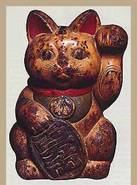
The most common belief is that the Maneki Neko originated during the Edo Period. The existence of this talisman became more documented and widely known through the Meiji period. One of the historical accounts attributes Maneki Neko’s popularity during this period to the sex industry. It was during the Edo Period that Japan isolated itself from the rest of the world and “an indigenous ‘amusement’ culture grew side by side with the expanding power of the merchant class.”5 There emerged many prostitution houses where they displayed lucky charms in the form of male sexual organs on ‘good-luck shelves.’ But when Japan opened itself back up to the rest of the world during the Meiji Restoration, there was “a ploy to minimize the negative image of Japan among the largely Christian Western world.”5 Therefore, the use of these charms disappeared because the government banned the use and sale of the male sexual organ charms. Interestingly enough, the disappearance of these charms seemed to parallel the increase in use of Maneki Neko.
However there is also a story that perhaps provides the background of how the cat’s statuary image evolved. It tells of an old woman living in Imado who was forced to sell her cat because she was too poor. After she sold the cat she began to have dreams that the cat told her to make its image in clay. She did as the cat said and sold it. Soon she became very wealthy from selling these figures.6
Variations and Adornments
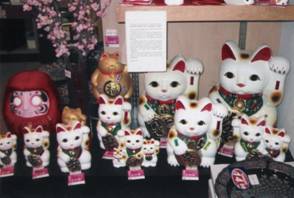
Today, the Maneki Neko is widely used in Asian shops and restaurants. It comes in several variations in size, color and meaning. The most noticeable variation in Maneki Neko is the use of different colors, which are used to represent different fortunes. The most popular and common ornament is the tricolor figurine, which is similar to the coloring of calico cats and is considered to be especially lucky.7 “This belief may be related to the rarity of this coloring in the Japanese bobtail cats, after which the Maneki Neko is modeled.”8 Other colors, according to a Japanese teacher at a local community college, consist of black tones that wards off evil or cure illness in children, white which means prosperity and happiness, and gold for wealth.
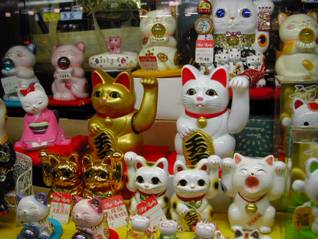
Along with color variations, the cat’s gesture plays a factor in the fortune Maneki Neko brings. Maneki Neko figurines can be found with either the left paw, right paw, or with both raised. “The most common belief is that the left paw raised brings in customers, while a right paw brings wealth and good luck.”9 In Japan, the majority of these cat figurines are holding their left paws up. It is interesting that different forms of Maneki Neko are used to express cultural differences. “In Japan, the Beckonin Cat shows its ‘palm’ outward, to simulate the way the Japanese beckon. However, the ‘Dollar Cat,’ made for export, shows the back of the paw outward, to represent the beckoning gesture in European countries and America.”10 It is also said that the height of the position that the paw is raised also makes a difference. The higher the paw is raised the more luck Maneki Neko brings. And it is because of this belief that throughout the years, it seems that the height of the paw has increased significantly; traditionally the position of the paw was located below the head.11 An alternative to this belief that is said, “the higher the paw, the greater the distance good fortune will come from.”12
Maneki Neko is typically wearing a bib, collar and a bell around its neck. “These items are most likely an imitation of what was common attire for cats in wealthy households during the Edo period.”13 During that time, red collars were popular and the bells were used to keep track of their cats.14 The use of the bibs on Maneki Neko seems to be more for decorative reasons but some sources say that it could be a link to the Jizo Bodhisattva god. This god was a protector and guardian of the sick. The Japanese used to decorate these statues with bibs similar to the ones found on Maneki Neko.
A final adornment found on Maneki Neko is the large gold coin-like object that hangs around its neck. According to a Japanese teacher, the object, called koban, is supposed to represent money in the form of gold—the most valuable form of currency that was used during the shogun era. This is yet another aspect of the cat that further links it to wealth and good fortune.
Maneki Neko Today
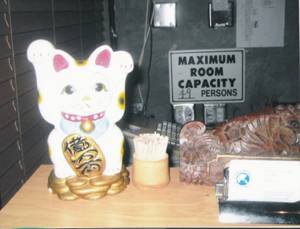 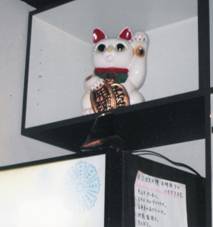
The Maneki Neko has become a very common and familiar figure in the Asian community. “Because the Beckoning Cat had lured a wealthy patron to the poor temple, images of this cat soon became talismanic emblems and were particularly favored by shopkeepers.”15 By displaying the cat in stores and restaurants, it is said that it will bring more customers and good fortune.16 Maneki Neko “is to be found at the entrance of restaurants and shops, where with its ingratiating feline qualities and uplifted paw, it may invite customers and bid them enter.”17
According to a Japanese teacher at a local community college, the Maneki Neko used to be purchased only for businesses to bring in prosperity. However, the cat is now displayed by people for fun and decorative purposes. When asked about Maneki Neko, an owner of a sushi bar in Santa Ana, CA explained that when he opened his store, friends had given it to him as a gift of friendship and to help bring luck to his new business. Whereas traditionally, Maneki Neko was supposed to be placed at the entrance of a restaurant or shop, that custom has since disappeared. The sushi bar owner further explained that it does not matter where you place the figure—what matters is the idea of having it there in his store.
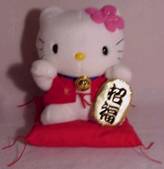 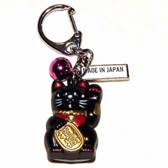 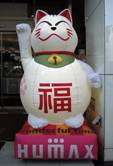
There have also been many more updated and modern adaptations to the traditional folklore associated with Maneki Neko. Deviating from the traditional clay, paper mache or wooden figurines, Maneki Neko can now be found in the form of keychains, piggybanks, chopsticks, air fresheners as well as many other different forms such as sumo cats and even in the form of other animals.18 More variations in colors have also emerged as well as changes in existing color meanings, which also represent the changing needs and mentality of society today. The color pink has been added to bring love and relationships, blue for family well-being as well as green for successful entrance exams.19 “Today, the black Maneki Neko is reportedly gaining popularity among ladies to ward off stalkers.”20
With the huge popularity of this figure spread all over Asia, there emerge similar manifestations of the notion of Maneki Neko. The Thai goddess of prosperity Nang Kwak is, “Originally depicted as a young woman kneeling with a money-bag on her lap, [she] is now generally shown making the Beckoning Cat’s raised-hand gesture, and sometimes is even given a cat’s tail.”21 The people in Thailand regard this figure similarly to that of Maneki Neko’s believers. Nang Kwak is supposed to promote prosperity to shop owners and restaurants, so figurines of Nang Kwak can be found in many stores.
Though the exact source of Maneki Neko is still unclear it is easy to see why its significance has been recognized by so many cultures besides its own. The idea that such an ordinary object as the cat could bring financial luck is simply an idea much too enticing to pass up. The appeal of the Maneki Neko has spanned generations and only gets more popular as time passes. In recent years the original symbolism has expanded to include love, health, and luck in prospects beyond finances. The Maneki Neko has taken a more prominent role in the Asian culture. It is possible to see the Maneki Neko as a more prominent figure outside of Asian culture in the future, as its new roles are adopted by other cultures.
|
 |











